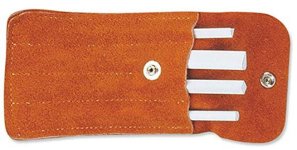I almost always prefer using Arkansas stones on firearms over files. Files remove too much metal per stroke, leave rougher surfaces and risk rounding off flat surfaces. AK. stones are not really rated with grit numbers but rather medium, fine, extra fine, super fine.
I have an array of Arkansas Stones that range from 1/8" x 1/8" x 2" all the way up to 2" x 10" x 3/4" and lots of sizes and grits in between. I almost always use honing oil with them and always clean them after use. Nothing worse than trying to do a good job with a clogged stone. Because Ak. stones work slower, the risk of going too far is minimized and when you reach the intended dimensions there is no need to go to a finer grit to polish - its already been done.
As mentioned above, a 1/4" piece (or thicker) of plate glass with fine grit Emery, Crocus or sand paper works well on flat metal - just go slow and check your work often. The glass and Silicone Carbide paper can also be used to true up the stones every once in a while as needed.
HINT: Before removing any metal, the best way to smooth out a Revolvers lock work is to shoot it. After 1000 rounds you should not have much left to do. Nothing is better at mating up contact surfaces by working the gun in with live fire. The benefit is you also get practice while doing so and gain familiarity with said Revolver. Any parts that are not smoothed out or still have burrs can them be addressed with the Arkansas stones.

